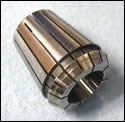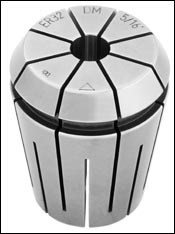Be Kind To To Your Collets
Collet toolholders are too important to the machining process to use them incorrectly. Follow this simple advice.
Share




The way a collet was designed to be used usually differs from the way that collets are used in practice. This is unfortunate given the critical role that collets play. A collet is the wedge between the toolholder and the cutting tool. This wedge, not the toolholder itself, is what does the actual tool holding. By gripping and positioning the tool, the collet determines both clamping force and runout, and therefore it can also determine the very ability of the process to produce a good part. Improving how well collets are used and cared for is an easy way for the shop to make better use of its tools. This article offers some simple advice.
Perhaps the simplest advice of all relates to the detail that is most often overlooked: cleaning. Collets are coated in a thick, rust-prohibitive oil before they are packed and shipped. This heavy coating may be great at preserving the collet, but it’s horrible to leave on during use. The oil reduces gripping force and may also affect runout.
To remove the protective coating, spray collets with a thin cleaning oil, such as WD40. Usually, the collet can then just be dried with a towel.
If the collet has been in use for a while, it may have picked up deposits on its tapered areas. The deposits can be the result of dirt in the toolholder, workpiece material getting into the collet cavity, dirty coolant or even the burning of any oil that was left on the collet’s surface. When trying to remove one of these deposits, avoid implements that will remove or deform the collet’s metal. A simple, lightweight brass brush is probably the best cleaning tool to use. This can be used with or without a cleaning agent. If the deposit can’t be removed this way, then it’s time to replace the collet. Foreign matter on the collet that is big enough to see will affect how well the collet performs.
Clean the inside of the collet as well. The same light oil such as WD40 also works here. After cleaning, visually inspect the ID for any debris or signs of damage.
Finally, clean the slots. The slots provide the collet with its ability to collapse and hold the tool, so anything inside a slot that gets in the way of this collapse will reduce the clamping force and increase runout. Thoroughly clear the slots of debris using a thin metal or plastic blade.
Signs Of Misuse Or Damage
After cleaning the collets, check them for signs of misuse. This inspection takes only a moment and can usually be done during the toolholder assembly process. Here are the signs to look for:
Is there a gouge around the nose of the collet? This means the collet and nut have been assembled incorrectly. The collet can’t be fixed once it has been damaged this way.
Is there a deep line around the collet gage line? This indicates the tools have not been inserted to the minimum depth required for clamping.
Has the collet lost roundness? Either in the hole or around the outside form?
Are there burrs on the collet?
If the answer to any of these questions is yes, then replace the collet.
What Can Cause Poor Runout?
After cleaning and visual inspection, proper assembly of the toolholder is the next important step. There are various ways that even a good collet can contribute to poor runout because of some aspect of the toolholder assembly. Here are the most common problems my company has seen:
1. Improper collet-to-nut assembly. In an incorrect assembly, the collet is placed in the holder first, then the nut is clamped on. In a correct assembly (pictured in the photo at the beginning of this article), the collet goes into the nut first, then the tool is inserted and then the nut is screwed onto the holder. The incorrect assembly can cause runout as high as 0.001 inch.
2. Not inserting the tool deep enough into the collet. For every collet there is a rated minimum tool depth. If the tool is clamped in place at a more shallow depth than this, runout will occur as the collet deforms incorrectly.
3. Over-tightening the nut. Turning the nut too tightly will also deform the collet in a way that leads to poor runout.
4. A bad pull stud. The pull stud, or retention knob, is screwed in at the end of the toolholder’s taper. In a case where this stud or knob was worn, the author has seen a runout of 0.001 inch. Replacing the stud (and making no other change than this) brought runout down to 0.0001 inch.
How To Get Better Runout And Higher Clamping Force At The Same Time
So much for the possible causes of poor runout. What can the user do to actually improve the collet toolholder’s performance? Here are some tips:
1. First, clean the assembly—not just the collet, but also the nut and holder.
2. Put a light coat of oil on the outside of the collet. There should be enough oil to coat the collet, but any excess is too much. The purpose is just to reduce any friction between the collet and the toolholder when the collet is pushed into the cavity. A collet that slides more easily lets the nut apply more of its torque toward pushing collet into the holder and closer to the centerline. The result is better runout and higher clamping force.
3. Make sure at least 2/3 of the collet’s gripping surface is used. If the tool is not inserted to the collet’s minimum depth, then an improper deformation of the collet will lead to runout. Failing to use the correct depth will also fail to capture the amount of shank required for the collet to achieve its intended gripping force.
4. Make sure the tool isn’t pushing against a metal backup screw. Some holders provide this screw as an adjustment aid to set the tool length. This screw can get in the way of holding the tool as securely as possible. The problem arises when the collet is free to move slightly during toolholder assembly, but the tool is constrained against this screw. The resulting friction between the moving collet and the stationary tool can reduce the clamping force. Our studies have shown that it can reduce the force by up to 50 percent.
5. Using a tool with a Weldon flat can also bring about a lower clamping force. While a tool with a Weldon flat can indeed be used in a collet, the tool will see less clamping force by up to 30 percent—or just about the same area that the flat takes up along the clamping length.
6. When tightening the nut, torque down on it only to the value specified for this nut. Use a quality torque wrench to observe this limit. Exceeding the torque does not provide more clamping force; it just leads to runout. In fact, the more force is applied, the more the top of the collet wants to twist with the nut. Too much force can actually twist the collet’s top, deforming the collet, which will increase runout and reduce clamping force.
7. Avoid this collet-twisting phenomenon by using a nut that reduces the friction between the nut and collet. Different varieties of nuts achieve this low friction using an impregnated coating, a ball bearing or a friction bearing.
Collet toolholders are ineffectively used in many shops. By following all of the advice above, a shop can realize greater holding strength and better precision from its collet toolholders than what many shops are able to achieve.
About the author: David W. McHenry is a product engineer for toolholder and collet supplier Rego-Fix Tool Corporation (Indianapolis, Indiana).
Related Content
Lyndex-Nikken Toolholders Offer Stable, Versatile Machining
Polygonal shank toolholders provide a rigid connection between the tool and machine — ideal for all processes both in turning and milling.
Read MoreHow to Troubleshoot Issues With Tool Life
Diagnosing when a tool is failing is important because it sets an expectation and a benchmark for improvements. Finding out why gives us a clue for how to fix it.
Read MoreRego-Fix’s Center for Machining Excellence Promotes Collaboration
The new space includes a showroom, office spaces and an auditorium that will enhance its work with its technical partners.
Read MoreFive Common Mistakes Shops Make with ER Collets (And How to Prevent Them)
Collets play a crucial role in the machining process, so proper tool assembly and maintenance is important. Here are five potential pitfalls to avoid when using ER collets.
Read MoreRead Next
Setting Up the Building Blocks for a Digital Factory
Woodward Inc. spent over a year developing an API to connect machines to its digital factory. Caron Engineering’s MiConnect has cut most of this process while also granting the shop greater access to machine information.
Read MoreBuilding Out a Foundation for Student Machinists
Autodesk and Haas have teamed up to produce an introductory course for students that covers the basics of CAD, CAM and CNC while providing them with a portfolio part.
Read More5 Rules of Thumb for Buying CNC Machine Tools
Use these tips to carefully plan your machine tool purchases and to avoid regretting your decision later.
Read More

































